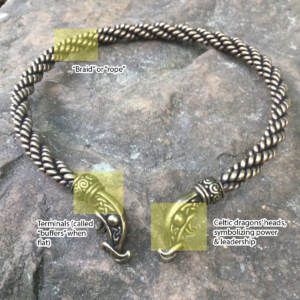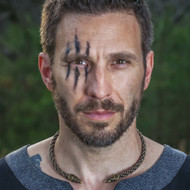Torcs and Their History
Posted by The Celtic Croft on Jun 22nd 2022
What is the Celtic Torc?


Essentially, a torc is a thick metal necklace with an opening in front. Torcs have been unearthed dating as far back as 8 B.C. in multiple areas of the world. While not exclusive to Celtic culture, they’re regarded as one of the dominant ancient Celtic art-forms. Torcs serve a purpose both practical and decorative. These eye-catching necklaces symbolized status, heritage, and strength when worn. Plus, they functioned to store wealth when made of precious metals. Because of historical cultural trade and overlap, you’ll frequently see torcs in depictions of ancient Viking culture as well as Celtic. Worn by both men and women, torcs are as compelling of statement pieces today as they were over 2000 years ago.
Anatomy of a Torc

The parts of a torc are relatively simple. Most of it is made of a solid metal, or metal wires twisted together. The name “torc” comes from the Latin “to twist” (think of how drill power is measure in torque). At the rope’s ends are two disconnected terminals. When flat, these terminals are referred to as “buffers”. In many Celtic torcs, the terminals will end in animals, each holding their own symbolism. Here, we have a couple of Celtic dragons. Naturally, these symbolize power, strength, and leadership.
How to Wear
When it comes to torcs, the opening should always face forward, with the terminals resting on the collarbone. Torcs can be quite thick and heavy, and without a clasp, some wonder how you can fit your head or neck into these. Since they’re made of braided wire, these hefty necklaces have a surprising amount of give. Stretch the neck opening an appropriate amount, place it on backwards, and twist back around so that the terminals face forward.

Another interesting historical theory: You know how when you bend a wire back and forth, while flexible at first, it eventually snaps? Numerous ancient torcs have been found with apparent repairs made to snapped wires (like the one above). This may imply that they saw frequent (not just ceremonial) wear that caused them to bend frequently enough to snap. Since a discreet repair would have been possible at the time, the distinct nature of the repair might suggest that having a torc in your family long enough for it to have broken was something to be proud of!
Symbolism
 Nationalmuseet, CC BY-SA 3.0
Nationalmuseet, CC BY-SA 3.0
Like much of Celtic and Viking art, torc details draw heavily on nature and the symbolism it entails. This picture shows Cernunnos, the Celtic Horned God, both holding and wearing a torc. What’s displayed on the terminals says a lot about the wearer. I’ve hand-picked a small number of our torc selection to share the range of symbolism found in torcs:
Cats: Independent, feminine, a guardian. Associated with the mystical and paranormal. Mysterious, capricious.
Chieftain’s torc: Instead of an animal, this ultra-hefty torc features heavy hoops on the ends that resemble ancient findings in treasure hoards, like the Snettisham Hoard. This torc is reminiscent of the powerful warrior Queens and Kings of Celtic folklore.
Greyhound: Hunting, healing, bravery. Hounds appear in literature and lore dating back centuries. Beloved by chieftains, warriors, and kings. And of course, loyalty.
Ash Leaf: A sacred druidic plant. Connection to creativity, and to other worlds. Important in both Celtic and Norse folklore.
Hare: Connection with Earth and family. Perception, patience, and perseverance.
You can explore our full collection here. If neck torcs aren’t your thing, we also carry “torc-style” bracelets and arm rings. Thanks for reading, and shout-out to our partners at Crafty Celts for their amazing work.

